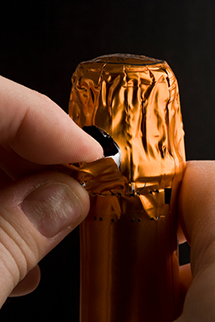Opening Champagne
How to open champagne is an excellent question due to common misconceptions. Opening a bottle of champagne often goes hand in hand with a celebration and it is tempting to let the cork fly and shower a bit of bubbly. Opening champagne in that manner may be something that is expected after winning the Superbowl or World Cup, but it is not the appropriate method for serving a good bottle of champagne. The two main concerns when opening a bottle of champagne are safety and preserving the effervescence. When the cork flies off, both of these points are neglected. Regarding safety, remember, although some styles of champagne may have slightly lower pressure, the typical pressure inside a bottle of champagne is 5 to 6 atmospheres (up to 90 pounds per square inch). That pressure is about the equivalent of an 18 wheeler semi-trailer truck tire or the tire of a double-decker bus. This is not something you want to handle lightly or take for granted. Aside from safety, the other consideration is loss of bubbles. When the bubbles and foam are flying out of the bottle there is less effervescent bubbles to provide the delight they bring in their mesmerizing appearance in the glass and the pleasure they bring from the experience and texture on your palate.
After you purchase a new bottle of champagne it is best to let it rest for a day or so after transporting. On a recent trip home from Champagne and a suitcase with a couple of excellent bottles packed inside I was advised to let them rest about 2 weeks after the transatlantic flight so they could settle and adapt to the differences in altitude, etc. In any case make sure you don’t jiggle and shake the bottle prior to opening. When you open a bottle of champagne, it should be well chilled. The lower temperature subdues the pressure and lessens the likelihood of the cork popping and the champagne foaming out of the bottle. Put it in the refrigerator for about 3 ½ to 4 hours or submerge it as much as possible in an ice bucket with about half ice and half water for about 30 to 40 minutes if it has been stored at cellar temperature. You should make sure the level of cold liquid in the bucket is near the level of the liquid in the champagne bottle so it will be uniformly chilled. After it is chilled, remove the bottle from the bucket and wipe it with a cloth. Cut the foil just below the area of the wire cage or pull the tab around the capsule if one is present and remove it. Always make sure to point the bottle away from yourself and other people as well as any items that could be easily damaged. Place one thumb firmly on the top of the cork and maintain pressure. Twist the looped eyelet on the wire muzzle or cage (called muselet in French) 6 half turns counter-clockwise (very rarely you may come across a muzzle that requires clockwise turns). For the next step, there are two schools of thought. You can either remove the wire cage as you continue to manipulate your thumb and hand to keep pressure on the cork or you can loosen the cage and leave it in place. The thought behind removing the cage is to have one less obstacle that could fly off and potential cause damage while the thought behind leaving it in place is that maneuvering your thumb and hand to remove the cage is more risky than leaving the cage on. I was originally taught to remove it. My current practice is, if it comes off the cork easily, I remove it. If it is somewhat imbedded, I leave it in place. In either case, keep the thumb intact and place a cloth over the top of the cork. At this point, if it the cork does happen to pop, it will go safely into the cloth. The next step is to remove the cork. Again, there are two schools of thought. One is more impressive but takes some practice: Point the bottle away from guests. Hold the cloth and cork in one hand and the base of the bottle in the other with your hand on the bottom of the bottle or keep a firm grip on the bottle about two thirds of the way down. Hold the bottle at a 30 to 45° angle to ease the uncorking. The second way is to place the bottle on a stable surface or even back in the ice bucket in case the pressure in the bottle causes you to lose your grip and drop the bottle if it backfires. Either way, at this point, gently turn the bottle (not the cork) and continue to put pressure on the cork. As the cork begins to ease out, tilt it slightly to allow a small amount of gas to escape with a gently sigh or hiss rather than a loud pop. When you start to hear the hiss, stop any rotation and continue to press on the cork. It will begin to ease out on its own at this point so keep pressing to slow the process. If you are new to opening sparkling wine, it may be a good idea to have a glass on hand to catch any overflow just in case there is foaming.
In rare cases when opening a bottle of champagne, you may encounter a stubborn cork that just won’t come out by normal means. Running lukewarm water on the cork may help. You can also try wrapping a towel tightly around the cork to get a better grip, then twisting the bottle. When all else fails, there are a few alternatives that can rescue you – sparkling wine pliers with two toothed jaws give a solid grip to loosen the cork, then remove manually as above. They also have nippers to remove the wire cage if it was somehow broken before it could be removed. If you run into trouble and don’t have sparkling wine pliers, a nutcracker can also accomplish the task. If the cork happens to break, you can use a regular cork screw to remove what is still in the bottle. In all cases be aware of the pressure inside the bottle and take appropriate precautions.
|





